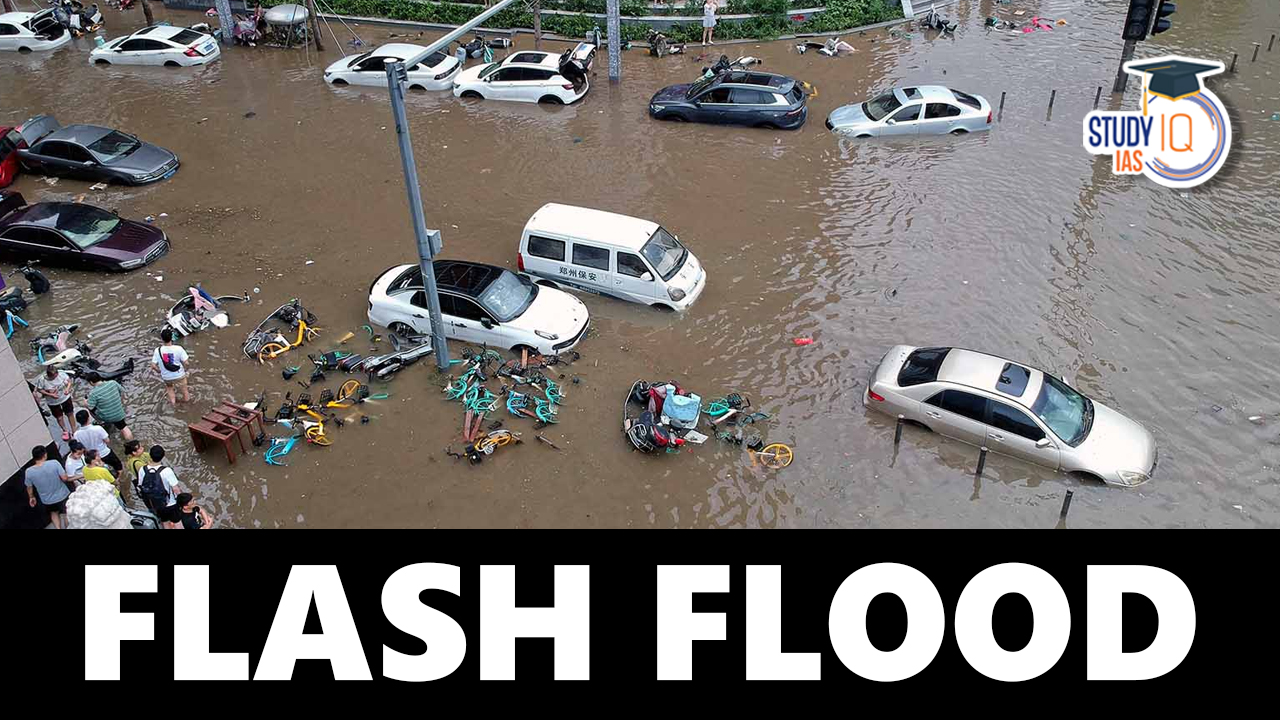Table of Contents
Context: At least 65 people were killed and over 50 reported missing after torrential rain triggered a flash flood in Chasoti village, Kishtwar district, Jammu & Kashmir.
Reasons for Flash Floods and Rain in J&K
Impact
- Loss of lives: Dozens killed and many missing.
- Community destruction: Remote villages like Chasoti, with poor access and infrastructure, face severe disruption.
- Cultural impact: The disaster struck during the pilgrimage route to Machail Mata, affecting religious travel.
- Wider pattern: The incident is part of an increasing trend of extreme weather events in J&K.
- Between 2010 and 2022, J&K recorded 2,863 extreme weather events and 552 deaths.
- Heavy snow caused the highest fatalities (182 deaths), followed by flash floods (119), heavy rain (111), and landslides (71).
- District-level risk: Kishtwar, along with Anantnag, Ganderbal, and Doda, has seen the highest casualties from flash floods.
Reasons for its Occurrence
Rising Temperatures
- Western Himalayas are warming at twice the rate of the Indian subcontinent post-2000.
- Warmer air holds more moisture (7% more per 1°C rise), leading to intense precipitation.
- Glacier retreat creates unstable glacial lakes; heavy rainfall can cause them to overflow, triggering glacial lake outburst floods (GLOFs).
Changing Pattern of Western Disturbances
- Western disturbances, traditionally active in winter months (Dec–Mar), now impact the weather year-round due to global warming.
- Extra moisture from the Arabian Sea strengthens these systems, producing heavier rainfall and flash floods in the Himalayas.
Topography of J&K
- Mountainous terrain makes the region prone to orographic rainfall (when moist air is forced to rise over hills, cooling and condensing into heavy precipitation).
- Steep slopes and fragile soils intensify the risk of landslides and flash floods.
Solutions
- Strengthen early warning systems: Expand Doppler radars and real-time rainfall monitoring in J&K.
- Disaster-resilient infrastructure: Reinforce roads, bridges, and housing in high-risk zones.
- Glacial lake monitoring: Map vulnerable glacial lakes using satellites and implement controlled drainage where necessary.
- Community preparedness: Train local communities in disaster response and evacuation drills.
- Climate adaptation policies: Integrate climate risk assessment into regional planning, tourism, and pilgrimage management.
What are Flash Floods?
Flash Floods are sudden, intense floods that occur within a short period, usually within six hours of heavy or extreme rainfall, dam break, glacier lake outburst, or rapid snowmelt.
Key Features
- Rapid onset: Little to no warning time.
- Short duration: Water levels rise and recede quickly.
- High intensity: Strong currents capable of sweeping away people, vehicles, and infrastructure.
- Localized impact: Often affects small areas but with severe damage.
Study on Flash Floods in India
Purpose & Scope
- Addresses the lack of granular data on flash flood vulnerability in India.
- Maps flash flood susceptibility across Indian sub-continental river basins using hydrological and geomorphological data.
- Identifies the Himalayas, Western Coast, and Central India as major hotspots.
Regional Drivers of Flash Floods
- Himalayas: Steep terrain and elevation drive high risk.
- Western Coast & Central India: High “flashiness” (rapid runoff) increases flood susceptibility.
- Within the Ganga Basin, southern Himalayan sub-basins are more prone than central stretches.
Causes & Risk Factors
- 75% of flash floods result from extreme rainfall + saturated soil
- Only 25% are caused solely by extreme rainfall.
- Saturated soil prevents water absorption, causing rapid runoff.
- Only 23% of extreme rainfall events trigger floods within six hours — prolonged rain is a bigger factor.
Climate Change Impact
- Warmer atmosphere holds ~7% more moisture per 1°C rise → heavier rainfall events.
Increase in extreme rainfall (1981–2020)
- Pre-monsoon: Doubled
- Monsoon: +56%
- Post-monsoon: +40%
- Winter: +12.5%
- Over 75% of flash floods (1980–2018) occurred during the monsoon.
- Flash flood incidents have risen sharply since 1995, especially in the Brahmaputra, Ganga, and Krishna basins.
Shifting Flood Patterns
- 51% of previously non-prone sub-basins now show increased rainfall.
- 5% of non-prone areas now have higher streamflow (“wet hours”).
- Some existing flood-prone zones show reduced wet hours, indicating changing vulnerability zones.
Adaptation & Mitigation Strategies
- Region-specific plans considering topography, soil, and hydrology, not just rainfall intensity.
- Improve early warning systems & disaster preparedness.
- Invest in climate-resilient infrastructure.
- Update land-use planning & adopt integrated flood management.
- Identify emerging hotspots to adapt before risks escalate.
| Sikkim Flash Flood |
On October 4th, a devastating flash flood hit North Sikkim, triggered by a cloud burst over Lhonak Lake. The Tessta River surged, submerging 41 vehicles and leaving 30 Army personnel missing. The Border Road Organisation (BRO) initiated rescue efforts.
|
What is a Flood?
Flooding is the overflow of water onto typically dry ground. Floods can occur as a result of strong rains, incoming waves from the ocean, rapid snowmelt, or the failure of dams or levees. Even a few inches of water can cause destructive floods, or the water can reach a house’s roof. Floods can happen suddenly or gradually over a long period of time, lasting for days, weeks, or even longer. Of all weather-related natural disasters, floods are the most prevalent and extensive.
Flash floods are defined as floods that occur within six hours of severe rainfall or for another cause. Flash floods, however, can occasionally happen minutes or a few hours after a heavy downpour. They are basically quick flooding of low-lying places, such as washes, rivers, dry lakes, and depressions, known as flash floods. Flash floods are more dangerous than typical floods in terms of potential damage due to their unpredictable nature and brief duration.
Causes of Flash Flood
Flash floods are most common in arid places that have just received precipitation, although they can occur anywhere downstream from the origin of the precipitation, even many kilometres away. The causes of Flash floods are mentioned below:
- In just four months (June to September), about 75% of the total rainfall falls; during these months, rivers have a tremendous discharge.
- It could be brought on by a hurricane, a tropical cyclone, a violent thunderstorm, or meltwater from ice or snow running over ice sheets or snowfields.
- Flash floods can also happen as a result of levee or dam breaks, mudslides, or debris flows.
- Flash floods have also happened following eruptions in locations on or close to volcanoes when glaciers melted from the extreme heat.
- The intensity of the precipitation, location and distribution of the precipitation, terrain and land use, vegetation kinds and growth/density, soil type, and soil water content all affect where and how quickly the flash flooding may occur.
- Orissa, West Bengal, and Andhra Pradesh’s coastal regions experienced depressions and cyclonic storms.
- The frequency/number of the aforementioned phenomena has grown due to climate change and global warming.
- Wildfires may be followed by the onset of flash floods. Forests and other types of vegetation are destroyed by wildfires, which weaken the soil and reduce its ability to allow water to permeate.
Effects of Flash Floods
Due to the sudden onset and quick water movement of flash floods, they are particularly hazardous. Though it provides little to no protection from being washed away, having a car can make people overconfident and less likely to avoid flash floods.
More than half of the fatalities associated with flash floods involve motorists who are swept away in their vehicles while attempting to cross flooded intersections. The majority of SUV-sized vehicles can be carried away by just 2 feet (0.61 m) of water. The effects of Flash Floods are:
- It affects the natural environment, including pollution, agriculture, vegetation, and geomorphology.
- The human population is affected (entrapments, injuries, fatalities).
- Among other classes of floods (such as riverine and coastal), they also have the highest mortality rate (measured as the number of deaths per many people impacted).
- With more than 5,000 lives lost each year, flash floods are among the deadliest natural disasters in the world. They also have a substantial negative impact on society, the economy, and the environment.
Government Initiatives on Flash Flood
Check the government initiatives on flash floods in India as mentioned below:
Flash Flood Guidance Services
The India Meteorological Department (IMD) developed a reliable system to deliver the required products in real-time to support the creation of warnings for flash floods about 6–12 hours in advance at the watershed level for the flash flood-prone South Asian countries, namely India, Nepal, Bhutan, Bangladesh, and Sri Lanka.
South Asian Flash Flood Guidance System (FFGS)
- The South Asian FFGS was introduced by the India Meteorological Department (IMD).
- It is intended to support emergency response teams.
- Aids in the prompt creation of evacuation preparations by governments before flooding occurs.


 Bonnet Macaques: Habitat, Features, Beha...
Bonnet Macaques: Habitat, Features, Beha...
 Places in News for UPSC 2026 for Prelims...
Places in News for UPSC 2026 for Prelims...
 Periyar Tiger Reserve, Map, Flora, Fauna...
Periyar Tiger Reserve, Map, Flora, Fauna...

























